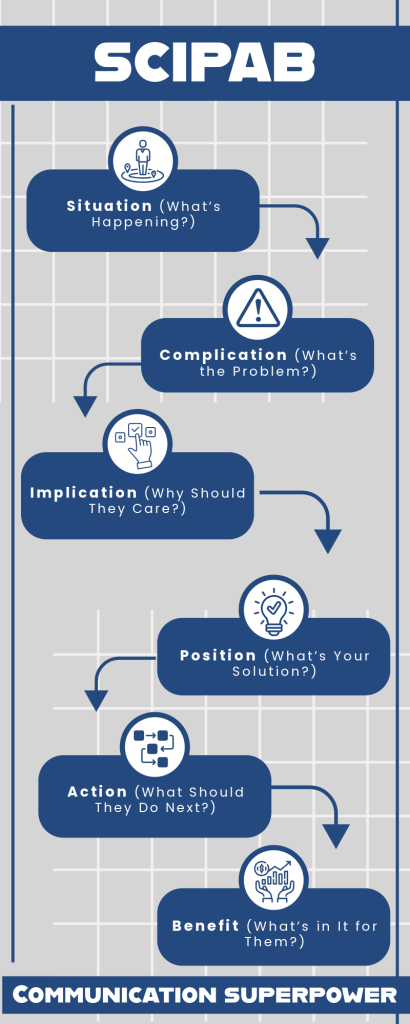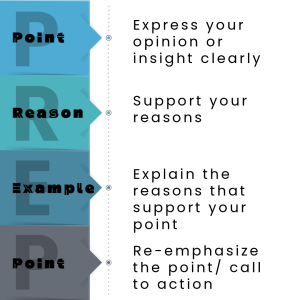3. Apply the SCIPAB Model and Other Frameworks for Structured Messaging
Ever listened to someone ramble on, desperately wondering, “Please, for the love of clarity, what is your point?” Of course, you have—we all have. Unstructured messages waste time, confuse listeners, and leave everyone frustrated. Enter SCIPAB—a proven, practical, and powerful communication framework that structures your messages logically and persuasively. It’s like GPS navigation for your ideas, ensuring your communication always lands smoothly at its intended destination.
And SCIPAB isn’t alone; there are other brilliant frameworks that make your communication concise and effective. Ready to ditch rambling and embrace structure? Let’s dive into SCIPAB and friends—your new secret weapons for crystal-clear communication.

SCIPAB: Your Communication Superpower
SCIPAB stands for Situation, Complication, Implication, Position, Action, Benefit. It might sound complicated, but trust me, it’s straightforward and powerful. SCIPAB structures your messages, guiding your audience logically from understanding the issue to taking specific action. Let’s break it down:
1. Situation (What’s Happening?)
First, set the stage. Provide context that your audience already knows or can easily understand. Keep it brief.
Example: “Our sales have steadily increased over the past three quarters.”
2. Complication (What’s the Problem?)
Now state the complication or challenge that interrupts the situation. This creates interest and urgency.
Example: “However, customer complaints have also increased, specifically regarding delayed shipments.”
3. Implication (Why Should They Care?)
State the consequences of not solving the problem. What happens if you do nothing?
Example: “If we don’t address these shipment delays, customer trust—and ultimately sales—will decline significantly.”
4. Position (What’s Your Solution?)
State your recommendation or solution.
Example: “I recommend implementing a new shipping provider with guaranteed delivery times.”
5. Action (What Should They Do Next?)
Tell your audience exactly what you want them to do specifically.
Example: “Please review the attached proposal and approve the new provider by next week.”
6. Benefit (What’s in It for Them?)
Explain how your solution benefits the audience.
Example: “Switching to this provider ensures timely deliveries, satisfied customers, and sustained sales growth.”
SCIPAB transforms your message into a concise, logical, and persuasive argument. No rambling, no confusion—just clear, structured communication.
Other Helpful Communication Frameworks (SCIPAB Isn’t Your Only Friend!)
SCIPAB is fantastic, but other frameworks can also structure your messages powerfully. Let’s quickly review two more simple and effective options:
 The PREP Framework (Point, Reason, Example, Point)
The PREP Framework (Point, Reason, Example, Point)
PREP is perfect for quick, persuasive communication. It concisely structures your argument:
Point: State your main idea upfront.
Reason: Provide a rationale or reason supporting your point.
Example: Illustrate your reason with a real-world example.
Point (again): Restate your main idea to reinforce your message.
Real-world Example (PREP in Action):
Point: “We should upgrade our customer support software.”
Reason: “Our current system is outdated and slow, frustrating customers.”
Example: “Last month, we lost three major customers due to long wait times and slow responses.”
Point: “Upgrading our support software is essential to retaining customers.”
Clear, concise, persuasive—PREP is your fast, effective structure for communication.
The Pyramid Principle (Start with the Answer)
The Pyramid Principle (popularized by Barbara Minto) flips traditional storytelling on its head: start with your key point, then support it with logical reasoning and details.
Lead with your main point: Provide the conclusion or recommendation upfront.
Group supporting arguments logically: Use supporting points that back up your main message.
Provide supporting evidence or examples: Illustrate each argument with data, examples, or rationale.
Real-world Example (Pyramid Principle in Action):
Main Point (top of pyramid): “We must expand into the European market by next year.”
Supporting Arguments:
“European demand for our products is growing rapidly.”
“Competitors are already establishing market share in Europe.”
“Expanding now will significantly increase revenue growth.”
Evidence:
“Sales forecasts show 20% growth potential in Europe.”
“Three key competitors already entered the market successfully.”
“Financial analysis confirms a positive ROI within 12 months.”
The Pyramid Principle communicates clearly, logically, and persuasively—your readers quickly grasp your main idea and see the logic supporting it.
Choosing the Right Framework
Different situations call for different frameworks:
Use SCIPAB when you need persuasive communication addressing a specific problem and proposing action.
Use PREP for quick, persuasive arguments supported by rationale and examples.
Use the Pyramid Principle for complex proposals, presentations, or documents where logical structure is critical.
Real-World Example: SCIPAB in Action
Imagine proposing a new employee training program:
Situation: “Our company has experienced significant growth, adding 50 new employees this quarter.”
Complication: “However, new employees report feeling overwhelmed and unclear about our company processes.”
Implication: “If we don’t address this issue, employee productivity and morale will decline rapidly.”
Position: “I propose a structured onboarding and training program clearly covering key company procedures and expectations.”
Action: “Please review the attached training proposal and approve it by next Wednesday.”
Benefit: “This training ensures new employees quickly become productive, confident, and satisfied, supporting sustained company growth.”
Structured, persuasive—SCIPAB transforms your communication
Quick Checklist: Structuring Your Messages
Ask these questions each time you communicate:
✅ Have I chosen an appropriate framework (SCIPAB, PREP, Pyramid)?
✅ Is my main idea stated upfront?
✅ Have I provided clear supporting arguments or rationale?
✅ Have I stated the action or next step I want my audience to take?
✅ Have I articulated the benefits to my audience?
Final Thoughts: Clear Structure = Clear Communication
Structured messages make your communication persuasive, effective, and impactful. Frameworks like SCIPAB, PREP, and Pyramid Principle aren’t complicated—they’re clear, practical tools transforming your ideas into powerful, persuasive messages.
Ditch rambling, embrace structure, and communicate clearly and successfully every single time. Ready to take your structured communication even further and master persuasive techniques? Excellent—let’s keep building your strategic communication skills confidently and powerfully.
